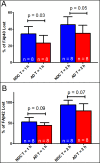Impaired hepatic amyloid-beta degradation in Alzheimer's disease
- PMID: 30192871
- PMCID: PMC6128628
- DOI: 10.1371/journal.pone.0203659
Impaired hepatic amyloid-beta degradation in Alzheimer's disease
Abstract
Extensive research strongly suggests that amyloid beta (Aβ) aggregates in the brain have a central role in Alzheimer's disease (AD) pathogenesis. Pathological Aβ deposition is likely due to an altered balance between overproduction and elimination. Rodent studies have suggested that the liver has a major role in Aβ degradation. It is possible alterations of liver function could affect brain Aβ levels through changes in blood Aβ concentration. In this study, we hypothesized hepatic Aβ degradation to be impaired in AD subjects. To test our hypothesis, an Aβ degradation assay was developed using synthetic fluorescein-labeled Aβ40 and Aβ42 spiked into human liver homogenates. Aβ degradation rates were lower in AD-derived homogenates as compared with those from non-demented (ND) control subjects, even after accounting for such covariates as age, sex, and APOE genotype. The protein expression of potential Aβ-degrading enzymes were also examined. Neprilysin levels were not different in AD liver samples, while cathepsin D and insulin-degrading enzyme were significantly altered in AD subjects. The results support the possibility that impaired hepatic Aβ degradation could be a factor contributing to increased brain Aβ accumulation and AD.
Conflict of interest statement
The authors have declared that no competing interests exist.
Figures



Similar articles
-
The amyloid-β degradation intermediate Aβ34 is pericyte-associated and reduced in brain capillaries of patients with Alzheimer's disease.Acta Neuropathol Commun. 2019 Dec 3;7(1):194. doi: 10.1186/s40478-019-0846-8. Acta Neuropathol Commun. 2019. PMID: 31796114 Free PMC article.
-
Physiological amyloid-beta clearance in the periphery and its therapeutic potential for Alzheimer's disease.Acta Neuropathol. 2015 Oct;130(4):487-99. doi: 10.1007/s00401-015-1477-1. Epub 2015 Sep 12. Acta Neuropathol. 2015. PMID: 26363791 Free PMC article.
-
GEPT extract reduces Abeta deposition by regulating the balance between production and degradation of Abeta in APPV717I transgenic mice.Curr Alzheimer Res. 2009 Apr;6(2):118-31. doi: 10.2174/156720509787602942. Curr Alzheimer Res. 2009. PMID: 19355846
-
Powering Amyloid Beta Degrading Enzymes: A Possible Therapy for Alzheimer's Disease.Neurochem Res. 2019 Jun;44(6):1289-1296. doi: 10.1007/s11064-019-02756-x. Epub 2019 Feb 26. Neurochem Res. 2019. PMID: 30806879 Review.
-
Are N- and C-terminally truncated Aβ species key pathological triggers in Alzheimer's disease?J Biol Chem. 2018 Oct 5;293(40):15419-15428. doi: 10.1074/jbc.R118.003999. Epub 2018 Aug 24. J Biol Chem. 2018. PMID: 30143530 Free PMC article. Review.
Cited by
-
A multitude of signaling pathways associated with Alzheimer's disease and their roles in AD pathogenesis and therapy.Med Res Rev. 2021 Sep;41(5):2689-2745. doi: 10.1002/med.21719. Epub 2020 Aug 11. Med Res Rev. 2021. PMID: 32783388 Free PMC article. Review.
-
Low Liver Enzymes and Risk of Dementia: The Atherosclerosis Risk in Communities (ARIC) Study.J Alzheimers Dis. 2021;79(4):1775-1784. doi: 10.3233/JAD-201241. J Alzheimers Dis. 2021. PMID: 33459646 Free PMC article.
-
Association between liver fibrosis and incident dementia in the UK Biobank study.Eur J Neurol. 2022 Sep;29(9):2622-2630. doi: 10.1111/ene.15437. Epub 2022 Jun 20. Eur J Neurol. 2022. PMID: 35666174 Free PMC article.
-
Peripheral blood amyloid-β involved in the pathogenesis of Alzheimer's disease via impacting on peripheral innate immune cells.J Neuroinflammation. 2024 Jan 4;21(1):5. doi: 10.1186/s12974-023-03003-5. J Neuroinflammation. 2024. PMID: 38178136 Free PMC article. Review.
-
Consequences of Amyloid-β Deficiency for the Liver.Adv Sci (Weinh). 2024 May;11(18):e2307734. doi: 10.1002/advs.202307734. Epub 2024 Mar 2. Adv Sci (Weinh). 2024. PMID: 38430535 Free PMC article.
References
-
- Tanzi RE. Molecular genetics of Alzheimer's disease and the amyloid beta peptide precursor gene. Ann Med 1989;21(2):91–4. - PubMed
-
- Hersh LB, Rodgers DW. Neprilysin and amyloid beta peptide degradation. Curr Alzheimer Res 2008. April;5(2):225–31. - PubMed
-
- Howell S, Nalbantoglu J, Crine P. Neutral endopeptidase can hydrolyze beta-amyloid(1–40) but shows no effect on beta-amyloid precursor protein metabolism. Peptides 1995;16(4):647–52. - PubMed
Publication types
MeSH terms
Substances
Associated data
Grants and funding
LinkOut - more resources
Full Text Sources
Other Literature Sources
Medical
Miscellaneous

